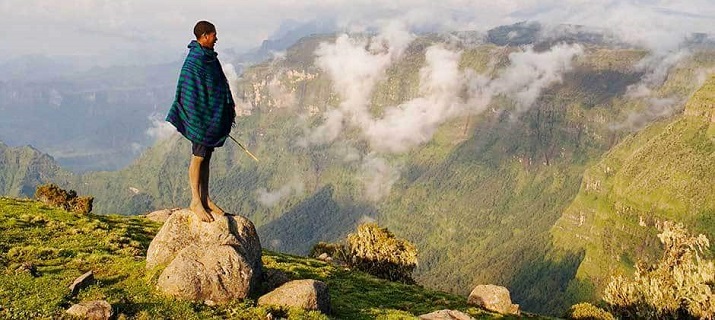
Ethiopia Tourist Attractions
Discover Ethiopia tourist attractions: Ethiopia, in the Horn of Africa, is a rugged, landlocked country split by the Great Rift Valley. With archaeological finds dating back more than 3 million years, it’s a place of ancient culture.
1. National Museum of Ethiopia
Ethiopia-Tourist Destinations: The National Museum of Ethiopia, also referred to as the Ethiopian National Museum, is a national museum in Ethiopia. It is located in the capital, Addis Ababa, near the Addis Ababa University's graduate school.
2. Gondar Fasil Ghebbi
The Fasil Ghebbi is a fortress located in Gondar, Amhara Region, Ethiopia. It was founded in the 17th century by Emperor Fasilides and was the home of Ethiopian emperors. Its unique architecture shows diverse influences including Nubian styles. The site was inscribed as a UNESCO World Heritage Site in 1979. Ghebbi is an Amharic word for a compound or enclosure. The complex of buildings includes Fasilides' castle, Iyasu I's palace, Dawit III's Hall, a banqueting hall, stables, Empress Mentewab's castle, a chancellery, library and three churches: Asasame Qeddus Mikael, Elfign Giyorgis and Gemjabet Mariyam.
3. Lalibela Church of St. George
The Church of Saint George is one of eleven rock-hewn monolithic churches in Lalibela, a city in the Amhara Region of Ethiopia. Originally named Roha, the historical and religious site was named Lalibela after the King Gebre Mesqel Lalibela of the Zagwe dynasty, who commissioned its construction. He is regarded as a saint by the Ethiopian Orthodox Tewahedo Church.
4. Aksum Axum Tsion St. Mary
The Church of Our Lady Mary of Zion is an Ethiopian Orthodox Tewahedo Church in Ethiopia. It is claimed to contain the Ark of the Covenant. It is located in the town of Axum, Tigray. The original church is believed to have been built during the reign of Ezana the first Christian ruler of the Kingdom of Axum, during the 4th century AD, and has been rebuilt several times since then.
5. Simien Mountains National Park | Ras Dashen
Ras Dejen, also known as Ras Dashen, is the highest mountain in Ethiopia and tenth highest mountain of Africa. Part of Semien Mountains National Park located in the Amhara Region, it reaches an elevation of 4,550 metres. The English form, "Ras Dashen" is a corruption of its Amharic name, "Ras Dejen", the term used by the Ethiopian Mapping Authority which alludes to the traditional head or general who fights in front of the Emperor.
6. Bahir Dar | Blue Nile Falls
The Blue Nile Falls is a waterfall on the Blue Nile river in Ethiopia. It is known as Tis Abay in Amharic, meaning "great smoke". It is situated on the upper course of the river, about 30 km downstream from the town of Bahir Dar and Lake Tana. The falls are one of Ethiopia's best known tourist attractions. The falls are 52 meters high, consisting of four streams that originally varied from a trickle in the dry season to over 400 meters wide in the rainy season. Regulation of Lake Tana now reduces the variation somewhat, and since 2003 a hydro-electric station has taken much of the flow out of the falls except during the rainy season. The Blue Nile Falls isolate the ecology of Lake Tana from the ecology of the rest of the Nile, and this isolation has played a role in the evolution of the endemic fauna of the lake. A short distance downstream from the falls sits the first stone bridge constructed in Ethiopia, built at the command of Emperor Susenyos in 1626. According to Manuel de Almeida, stone for making lime had been found nearby along the tributary Alata, and a craftsman who had come from India with Afonso Mendes, the Orthodox Patriarch of Ethiopia, supervised the construction.
7. Semien Mountains | Ras Dashen
Ras Dejen, also known as Ras Dashen, is the highest mountain in Ethiopia and tenth highest mountain of Africa. Part of Semien Mountains National Park located in the Amhara Region, it reaches an elevation of 4,550 metres. The English form, "Ras Dashen" is a corruption of its Amharic name, "Ras Dejen", the term used by the Ethiopian Mapping Authority which alludes to the traditional head or general who fights in front of the Emperor. And Mount Bwahit: Mount Bwahit is a peak of the Semien Mountains in the Amhara Region of Ethiopia. Its altitude is estimated at 4430 or 4437 m above sea level, making it the third highest mountain in Ethiopia and the 13th or 14th highest mountain of Africa. It is located about 16 km west of the highest Ethiopian mountain, Ras Dashen, from which it is separated by a 1,600 m deep gorge. The connecting ridge goes NNE over the Arkwasiye Pass, eastwards over Kidis Yared, at 4,453 metres the second-highest mountain in Ethiopia, and SSE over the Metelal Pass to Ras Dashen.
8. Lake Tana
Lake Tana is the largest lake in Ethiopia and the source of the Blue Nile. Located in Amhara Region in the north-western Ethiopian Highlands, the lake is approximately 84 kilometres long and 66 kilometres wide, with a maximum depth of 15 metres, and an elevation of 1,788 metres
9. Harar
Harar is a city in eastern Ethiopia. It’s surrounded by a centuries-old defensive wall that has several large gates, including Duke's Gate. The city is known for its mazelike alleys and traditional houses decorated inside with flat hanging baskets. A replica house features at the Harar Community Centre Museum. A holy Islamic city, Harar has many mosques, including the Grand Jami Mosque with its tall white minarets.
10. Dallol
Dallol is a cinder cone volcano in the Danakil Depression, northeast of the Erta Ale Range in Ethiopia. It was formed by the intrusion of basaltic magma into Miocene salt deposits and subsequent hydrothermal activity.






 |
|  |
|  |
|  |
| 